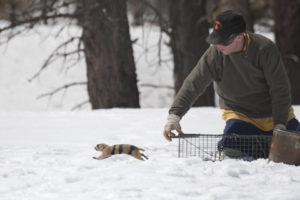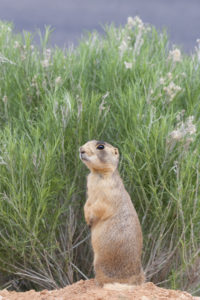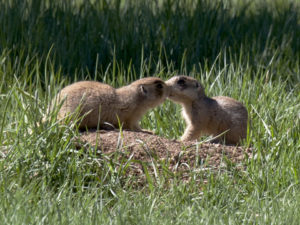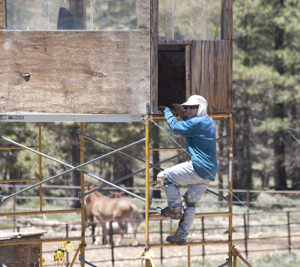
Have you ever crawled through a tunnel at the zoo and popped up through a hole in the ground, pretending you’re a prairie dog? Real prairie dogs dig complex systems of underground tunnels. Their burrows can be as deep as five meters (about 15 feet) and as long as 20 meters (about 60 feet). Since 1974, Behavioral Ecologist John Hoogland, a Zoologist, has been watching prairie dogs pop in and out of burrows in states such as Arizona, Colorado, New Mexico, South Dakota, Utah, and Wyoming.
Prairie dog burrows include turn-around areas near the surface (where they listen for predators and alarm calls of other prairie dogs), nursery rooms for their babies, and rooms for sleeping. The entrances of most burrows have large mounds. These hills of dirt, which can be more than one meter in diameter and one meter in height, help ventilate the burrows by pulling breezes underground. The mounds also prevent the burrows from flooding when it rains. When they sense possible danger, prairie dogs run to the mounds, which help them look around for predators such as badgers, bobcats, coyotes, and golden eagles.
As a graduate student in zoology, Hoogland studied the bank swallow, a bird that lives in large colonies. Curious about whether his findings about bank swallows apply to mammals that live in colonies, Hoogland began to study prairie dogs. For over 40 years, he has studied the social lives of his favorite animals by exploring the ways they communicate, cooperate, and protect themselves from predators and other prairie dogs.

John grew up in West Virginia, where he went to a small high school with “an outstanding science teacher. I had him for physical science and biology.” Hoogland was “in the right place at the right time” and “I knew I would do something in science. That teacher set my course for the next 50 years.”
Another turning point for Hoogland was in college, when “I was thinking about being a medical doctor, to look down throats and into eyes and ears.” In his last year of college, Hoogland took a course from Richard Alexander, who taught behavioral ecology. Hoogland thought, “Golly, this is what I really want to do. Forget medical school.” Professor Alexander studied crickets, naked mole rats, and humans and taught Hoogland about many animals and how their behaviors “relate specifically to humans and why we do what we do.”
Like mice and gerbils, prairie dogs are rodents. They are in the squirrel family with chipmunks, ground squirrels, tree squirrels, and woodchucks. The five species of prairie dog all live in North America. Some species, including white-tailed prairie dogs, hibernate through the coldest winter months. Other species, like black-tailed prairie dogs, do not hibernate. At about 30 centimeters long, prairie dogs look like fat tree squirrels with short tails.

Many prairie dogs give an alarm when they spot a predator nearby, calling out over and over. Why make so much noise when a hawk flies over or when a bobcat is nearby? Wouldn’t the alarm call make it easier for the predator to locate a colony and the prairie dogs who live there? Hoogland explains that “for animals in general, natural selection is all about producing babies that survive. If I am a male or female prairie dog with babies nearby and I see a predator, I’m going to give a call.” Prairie dogs give the alarm to warn their babies so that the pups can quickly reach safety.
Two of the four species Hoogland has studied only give an alarm call to protect their own pups. But Hoogland has observed adults in the other two species giving alarm calls to protect their nieces, nephews, and cousins, in addition to their daughters and sons.
How do Hoogland and his colleagues study prairie dogs? “We catch ’em, we mark ’em, and we watch ’em.” They build towers in the field containing a colony and climb into them to be ready for action at dawn, when prairie dogs wake up and begin to pop out of their burrows. Hoogland stays in his tower, watching and taking notes, until the prairie dogs go back underground at sunset.
Each autumn, Hoogland and his team catch and weigh all of the prairie dogs in the colony they are studying. Pups weigh 125-250 grams (about 4-8 ounces), while adults weigh 750-1,000 grams (about 1.5-2 pounds). Hoogland’s team inserts numbered eartags into each prairie dog they capture, and they also paint a unique mark on its side. These marks allow the scientists to identify each prairie dog for the rest of its life. Hoogland and his students capture, eartag, and mark the 200 or so adults and the 200 or so pups at their study colony each year. Then they count the ones that survive until the next spring, and until the spring after that, and until the spring after that….

Using binoculars to watch from their towers, Hoogland and his colleagues look and listen for prairie dogs giving alarm calls, running away from predators, or fighting and chasing other prairie dogs. Hoogland has discovered that adult prairie dogs sometimes kill the pups of other prairie dogs, probably to make it more likely that their own babies will survive. Interestingly, they are most likely to kill the same nieces, nephews, and cousins that they protect with their alarm calls. Many prairie dog moms also nurse their juvenile nieces, nephews, and cousins. How do they decide whether to harm or protect their relatives? Puzzles like this one dominate Hoogland’s research and keep him busy.
In the field, Hoogland and his students watch carefully for signs that a prairie dog has killed another prairie dog’s litter. “Whenever we see it, we record it. But we also document cases where killing doesn’t happen, because we want to compare the females and males who kill with the ones who don’t. We nicknamed one female ‘Killer Supreme,’ because she killed all the babies of eight different litters over three years. Wow!”

As he gathers data about each colony he studies, Hoogland uses estimation, percents, and other types of math to help him better understand prairie dog behavior. He uses calculators and computers to summarize and analyze his results. Like many scientists and engineers who talk with Math4Science, Hoogland wishes he knew more statistics and is grateful to math experts who help him draw conclusions from the information he collects.
Hoogland has great respect for the animals he studies: “I never put anything past prairie dogs. If it’s important, they’ll figure out a way to do it.” Thanks to Hoogland and his colleagues, we know more about wildlife on North America’s prairies.



